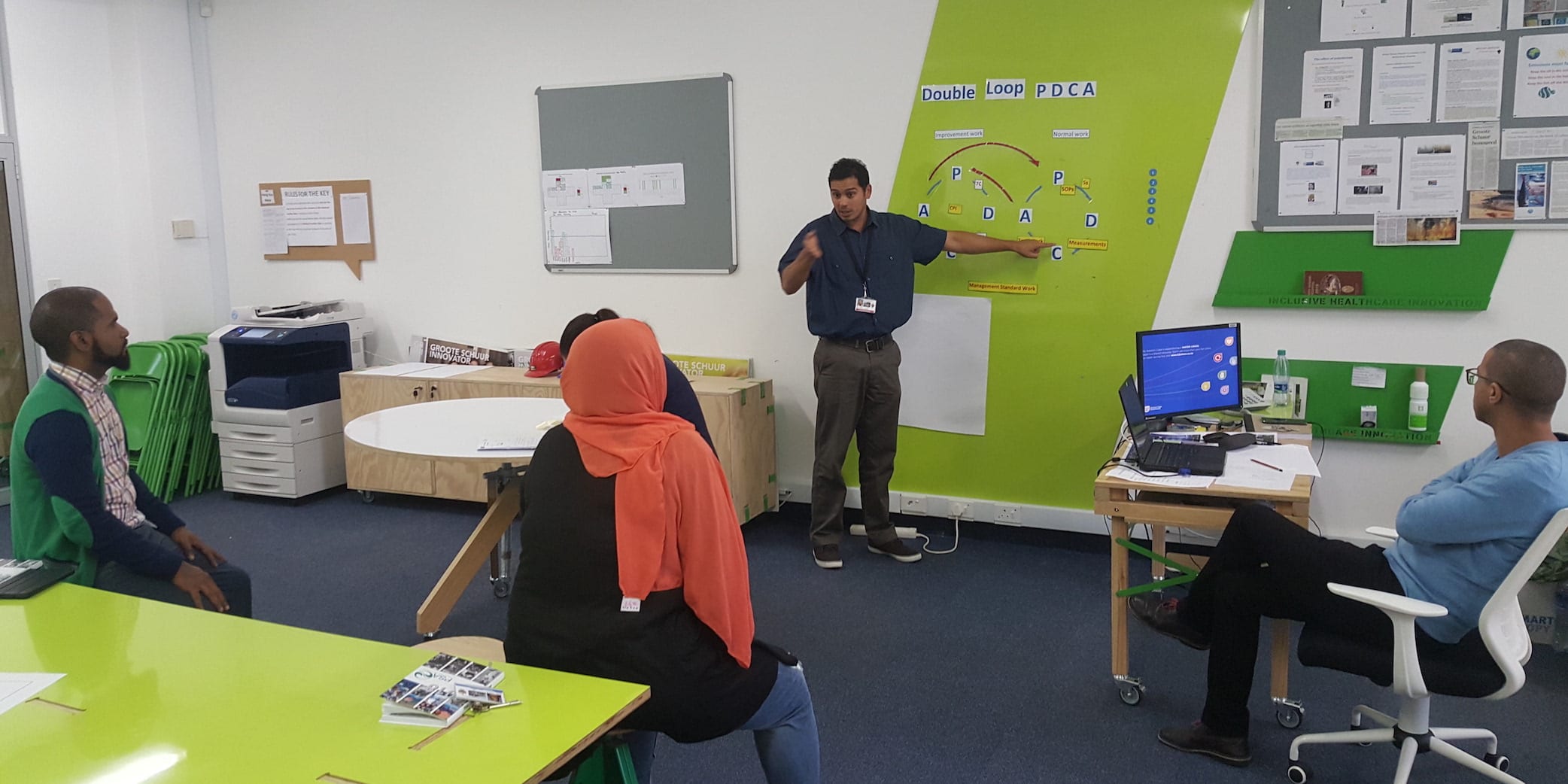
A Norwegian lean epic
CASE STUDY – Thousands of kaizens, a relentless focus on learning and the determination to continuously improve have made of this Norwegian company something of a lean epic tale.
Words: Eivind Reke, Organizational Secretary, Los Norge and Daryl Powell, Adjunct Professor at NTNU and Research Manager at SINTEF Manufacturing
Once upon a time, in the year 2007, there was a company named Fibo – a manufacturer of wet room boards and kitchen counters. One day, after sharing a factory with their old sister company-turned-competitor for the best part of 10 years, Fibo moved into a newly-built facility in Lyngdal, a small town on the south coast of Norway.
The financial crisis was looming, and the company expected a downturn in the market. This led them to looking inward and helped them realize their newly-built facility looked messy. The physical location of the factory had changed, but their culture had not. In fact, Fibo was struggling with profitability and posted a negative result for three years running – from 2006 to 2008.
However, then plant manager Torfinn Knutsen had attended a course on lean leadership and decided that this could be an interesting strategic approach for Fibo.
LEADERSHIP
Before changing anything in production, Torfinn and his allies on the leadership team knew they needed to convince the board that lean was the right thing to do. They also realized that, to make lean work, they had to change their own leadership practices and thinking. So, instead of only hiring a consultancy to help them to bring lean in their factory, they decided to also spend time reading and discussing books about lean, such as The Toyota Way by Jeffrey Liker and Lean Leadership for Learning Organizations by Norwegian author Bjarne Berg Wig.
They asked themselves the following questions:
- What would the 14th management principles presented in Toyota Way look like in their own language (Lyngdalian, from the name of the town)?
- What, in their own behavior, did they need to change to succeed?
- How could they create the conditions for on-the-job learning through practical problem solving and improvement work?
LEARNING
In total, the team spent 1,950 hours learning and training before doing anything with their factory. Finally, in early 2009, they felt they were ready to move forward, and on the 16th of March, 2009 the concept of “lean” (or TPM as they called it at the time) was first introduced across the company. Gathering and addressing the whole business in the canteen, Torfinn, along with former Hydro employee and TPM expert Bernt Nagel, discussed the history of lean and what this approach could mean for Fibo. Five pilot departments where given extra training that day. They were to focus their attention on 5S, operator-led preventive maintenance, quality issues (short stops), and standard work.
On one of the production lines, the team started analyzing each and every “short stop”. After a while, they started to see a pattern of causes related to one of the processes. This led them to dig deeper into this process, thoroughly cleaning one of the machines, marking all possible issues with red tags and solving each issue, one by one. Quickly, they began to notice the effects of their improvement work, with quality and machine utilization numbers getting better and better.
Between March and August 2009, Fibo established 21 active improvement teams that included 95% of the workforce. However, not everything was running smoothly. Some of the improvement groups were sabotaged by people who didn´t want to participate or did not completely understand the purpose, and this had a few negative effects. They also had to deal with the fact that their previous approach to management meant that the operators were not used to making decisions on their own, and there was little understanding of lean leadership and the need for leadership transformation. On the other hand, they had active support from the CEO and a dedicated internal lean resource from day one. The fact that the daily management meeting worked from the very beginning was a stroke of good luck. However, what really struck them after the first nine months was how the employees grew through added responsibility, and the genius of their employees, who came up with some great ideas for improvement. The improvement work was getting contagious, as if a benign spell had been cast on Fibo.

LONG-TERM VIEW
At this point in our story the management team and the employees at Fibo could have patted themselves on the back and ended the “lean project” with quite a lot of success. Instead, they looked ahead and asked themselves where they should go from there. The early success they had experienced had confirmed their initial hypothesis that lean was indeed more than just process improvement. It had strategic potential. To realize this potential, Torfinn and his team intensified the focus on people development. Every week, the management team would meet and discuss the current book they were reading, and develop PDCA exercises based on their discussions in order to test their learning in the real world. One of these exercises was Ohno’s famous circle.
At first, the operators didn´t know what to think. What were those guys doing? Why were their bosses standing there, hours on end, just looking at them? It was a bit creepy. Not to mention that Norway is a country where employees are often unionized and have real power in the workplace. Observing operators working is not a very common thing to do. While the union representative was supportive from day one, some of the operations didn’t approve of the changes the company was implementing. However, since Torfinn and his team had been very hands-on in supporting the improvement initiatives, the initial hostility quickly made way for eagerness for more learning and improvement. Soon after that, Fibo started its cross-functional book club and the operators themselves began to stand in the Ohno circle, observing each other, challenging each other, supporting each other.
At the beginning of this story, we said that when Fibo started their lean journey, they were expecting a downturn in the market due to, among other things, the financial crisis of 2007/2008. Amazingly, the opposite happened. The market started to prefer their products as a substitute to tiles in bathrooms and kitchens. From 2008 to 2010, Fibo increased production from 600,000 sqm to 900,000 sqm without investments in manpower or equipment. In other words, Fibo increased their productivity by 50% thanks to their lean effort.
In 2010, Monica Briseid was hired as a department manager for sales support and was challenged by Torfinn to make the department “the best lean department in Fibo”, a place that employees could look to for inspiration and learning. Her response to this challenge was instrumental in moving Fibo forward. As her previous job had been in a low-level supplier in the automobile industry, Monica had some experience with lean tools and thinking. At Fibo, she had the opportunity to develop her competence as a lean leader. By doing the basics right, she managed to develop the model department that Torfinn had asked of her. In the end, Monica’s department became a model for other companies in Norway. They even started to visit Fibo to learn from them.
By 2011, Fibo had recorded 4,000 implemented improvements, a number that would raise to 5,500 in 2012. By focusing their efforts on quality through 5S, operator maintenance, short stop analysis, standard work, and leadership and operator training, the culture of the company had indeed changed for the better. Improvement work had become part of “the way we do things”, there was a gradual change from “20 years ago” thinking to “what about tomorrow?”. More importantly, there was a willingness to try new things and a belief that everything could be improved. The management team could see that employee satisfaction was going up and that absenteeism was going down. At the same time, quality had improved, and the company was experiencing a marked rise in productivity. Always looking for the next step, Fibo started to work on reducing change-over time using SMED and continued to work with standardizing operations across the company. In turn, the focus on improvements and learning meant that people looked forward to going to work, and the genius of improvement ideas from their employees kept taking Torfinn and his team by surprise.
By 2013, Fibo had more than doubled their factory capacity, with some of the machines having seen an improvement in OEE from 45% to 87%. The company was making money. Lots of money! In 2008, their Operational Margin was zero. In 2009 it went up to 7%, in 2010 to 13%, and in 2011 it reached 16% before stabilizing around 15% over the next two years. The company was now averaging 30 improvements per employee per year. They had reduced their finished goods warehouse from 75,000 square meters to 39,000 square meters and used the extra space to introduce a new production line without expanding the factory building. At the same time, Fibo reached an all-time high of 384 different product variations.
Many companies would have moved on now, content with their lean effort and looking elsewhere for the next big thing they could use to improve their business. Not Fibo! They continued to look for the next step in their production process. To find the space to do this, they started a weekly cross-functional leadership meeting. The focus of the meeting was on quality and flow, and they used internal on-time-delivery measures to track their progress. The basic question was, “What issues have we had this week that have been a hindrance to the flow of production?” Every department manager or team leader in the organization participated. From the Customer Care to Warehousing, from Production to Purchasing. It was also around this time that Fibo developed what they call “the living process” – their Hoshin Kanri system designed to support each person in the company with the energy to improve and the direction of improvements. Lean was becoming their operating system for cultural change. Everyone from Torfinn to the operators were building lean competence, and team competence.
By the end of 2014, the improvement count reached 11,500. So, to keep what had now become an improvement juggernaut rolling, they defined a guiding star that said that every employee should think about and carry out improvements as part of their normal day-to-day activities, every day. This people-centric and down-to-earth approach to improvement was still driving them on through 2015. Again, the managers and operators at Fibo were able to achieve new improvements in quality, cost and delivery by focusing on the basics of removing the 7 wastes, focusing on continuous improvement and establishing the flow of material and information from raw-materials to shipment of finished goods to customers. Lead-time in production was shortened from 15 to 5 days (between 2007 and 2015), something that also led to a reduction of work-in-progress to 30% of the original amount and allowed for flexibility and visibility. Batch sizes in production were reduced by 55% and finished goods stock was reduced by 25% (at the same time, productivity more than doubled). The improvements they had made to the business performance of the company was now attracting the interest of investors, and by the end of 2015. Before long, Fibo was sold to a Norwegian private equity company.
But what had been the biggest change? Glen Andreassen, the HR Manager, and Gunnar Gabrielsen, the Plant Manager, said that the biggest change was in the way they think. Not just them, but everyone in Fibo now had a big-picture perspective that encompassed the whole company. Thinking and improving both the quality and the flow of production through visualization, improving internal customer/supplier relations through training in improvement tools and methods, through the use of both a daily management Obeya and a management Obeya, and by believing in and developing people.

UNDER EQUITY OWNERSHIP
Thanks to the ingenuity of their employees, Fibo had more than doubled the production capacity of their plant, with the same floor space, the same manpower in production, and with equipment from the 60s, 70s and 80s. Fibo’s new owners recognized the potential of a company that could radically expand its market out of Norway. Investments was needed for this, and investments was given.
Again, turning to the competence of their teams, Fibo was able to change the layout of production, remove old equipment (only two of the old production lines remain), while still running full production to meet the market needs. With new equipment came new issues that had to be tackled and, in many ways, it was back to basics for the Fibo team leaders and their teams. Once again, they had to: develop visual work environments with 5S together; analyze short stops to better understand the technical issues that came with the new production equipment; run SMED exercises to reduce change-over times; develop standardized work and work standards for the new equipment; train team members; and develop new maintenance guidelines through operator-driven maintenance and TPM principles.
By April 2019, Fibo had logged 23,000 implemented improvements (about 200 per month over a 10-year period), had almost tripled their sales volumes producing 2.5 times more per employee than they did in 2007, reduced lead-time and work-in-process in production by 300%, and have an average lead-time from sales to invoice of just over five days.
These are impressive numbers, but what is the important lesson that Fibo teaches us lean practitioners from around the world? That their focus throughout their lean journey has been on systematically building the capabilities of their people through. To do this, Fibo ran cross-functional book clubs that came to represent the foundation of the theoretical lean training. They systematically development management by creating time for reflection and discussions, and by practicing genchi genbutsu. They held daily management meetings and consistently improved the work. They celebrated achievements and enjoyed their victories together. They intelligently called their hoshin process “The Living Process”.
At Fibo, there is a sense that things can always be imporved. In fact, when we visited and spoke with them, they felt that their improvement work was slowing down. As outsiders, we could see and feel that the spirit of hitozukuri (making people), monozukuri (making things) and kotozukuri (the energy to make things happen) was alive and kicking at Fibo. And that they would likely live happily – or lean-y, rather – ever after.
THE AUTHORS


Read more


FEATURE – Waste in the agricultural sector is a significant threat not only to the environment, the economy and farmers, but also to food security around the world.


FEATURE – How “Double-Loop PDCA” was discovered due to a problem with implementing a lean daily management system in a South African hospital.


FEATURE – How does lean apply to learning? The author reflects on the lean transformation his schools are undergoing and on its practical implications on students, staff and leaders.


CASE STUDY – TechnipFMC has introduced the Concept Paper in its lean product development process. This article shares some of the learnings resulting from the experience.

